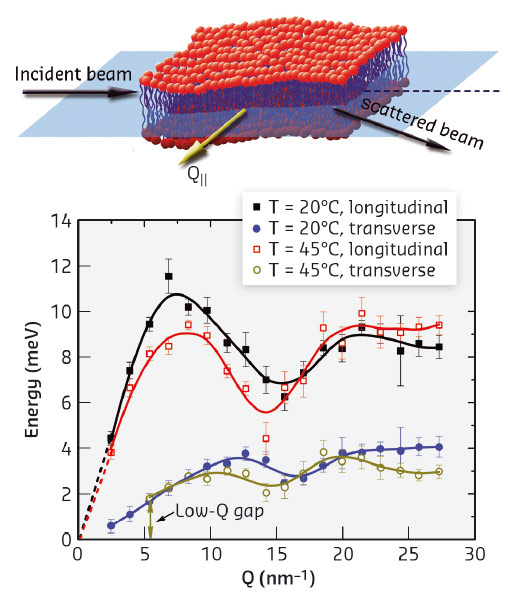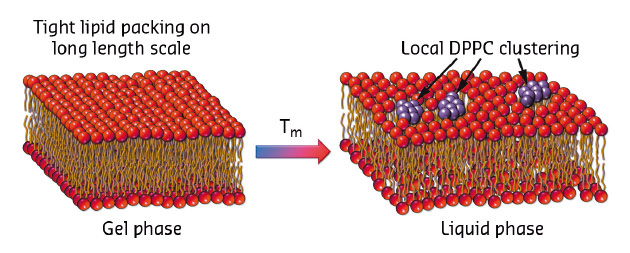- Home
- Users & Science
- Scientific Documentation
- ESRF Highlights
- ESRF Highlights 2016
- Electronic structure, magnetism and dynamics
- Phonon-mediated passive transport of solutes in lipid membranes
Phonon-mediated passive transport of solutes in lipid membranes
This study of the passive molecular transport through a lipid membrane has revealed evidence for the formation of transient voids through lipid density fluctuations from analysis of the phonon branches of a DPPC membrane. The finding supports the notion that passive transport is mediated by entropic expulsion of solutes from higher to lower lipid density regions within the membrane.
A biological membrane serves as a selective barrier between the internal compartment of the cell and the cell’s surroundings. Most biological molecules are unable to diffuse across the lipid bilayer. However, due to thermally induced vibrations in the membrane, a cell can passively transport molecules using these natural thermal motions. It has been shown experimentally that many factors define the permeation process including solute nature, molecule type and membrane thickness. Different theories were proposed to account for other parameters such as solute hydrophobicity, molecular size and shape, membrane fluidity and packing density. However, despite these efforts, inconsistencies still persist and the exact mechanism of passive transport still remains unknown.
We have used a new approach to study lipid dynamics, which pinpoints the importance of collective molecular excitations in passive transport across the lipid bilayer. Using the high resolution inelastic X-ray scattering (IXS) technique combined with a newly developed phonon theory of liquids [1], two important discoveries were made. First, the IXS experiment identified propagating in-plane transverse phonon modes in a DPPC (1,2-dipalmitoyl-sn-glycero-3-phosphocholine) lipid membrane that have not been experimentally observed before. Second, the measurements revealed the opening of a phononic gap in the transverse excitations with increasing temperature across the main (gel to liquid) phase transition.
The measurements were performed at beamline ID28, below (20°C) and above (45°C) of the main transition temperature (Tm = 41°C). Figure 18 illustrates the scattering geometry of the IXS experiment and the experimentally obtained longitudinal and transverse phonon dispersion curves.
 |
|
Fig. 18: (top) Geometry of the IXS experiment at beamline ID28: the incident and scattered beams (thus, the momentum transfer vector Q||) lie within the membrane plane to ensure that only the in-plane dynamics is probed. (bottom) Longitudinal and transverse phonon dispersion curves. Transverse phononic gap at high temperature is indicated by the arrow at Q ≈ 5 nm-1. The solid lines are to guide eyes only and the dashed lines extrapolate the longitudinal phonon dispersions to Q = 0. |
The observation of the phononic gap is highly significant as it reveals a possible mechanism of the transmembrane passive transport. Specifically, the results confirmed the theoretical prediction [2] that phononic interaction induces transverse phononic gaps in disordered materials. Such gaps are related to the diffusion and relaxation processes occurring in the lipid membrane and are a direct signature of short-lived (picosecond scale) local lipid clustering in the membrane over short-to-intermediate length scales (Figure 19). On long length scales, the opening of the phononic gap in the transverse phonon modes signifies the formation of short-lived voids stipulating that the transverse phonon propagation is no longer supported due to the increasing lipid chain disorder.
 |
|
Fig. 19: The formation of the short-lived DPPC clusters upon the phase transition from the gel to the liquid phase. In the liquid phase, the lipids arrangement in the membrane is mostly disordered, however, due to the thermal fluctuations, nm-scale lipid clustering is triggered (shown by dark purple colour). Rarified regions beyond the dark purple clusters denote the formation of transient voids. |
The results of the work support the notion that the local lipid chain disordering directly mediates solute diffusion across the membrane. The entropic expulsion of the solute from the higher to lower lipid density regions is essentially thermally-triggered. The simultaneous lipid clustering and voids formation provide the mechanism for the solute to diffuse across the membrane via hopping between voids. Both local lipid density fluctuations on short-to-intermediate length scales and void formation on longer length scales is clear evidence for the universal phonon-triggered mechanism of passive membrane transport.
Principal publication and authors
Revealing the mechanism of passive transport in lipid bilayers via phonon-mediated nanometre-scale density fluctuations, M. Zhernenkov (a), D. Bolmatov (a), D. Soloviov (b,c), K. Zhernenkov (d), B.P. Toperverg (e,f), A. Cunsolo (a), A. Bosak (g) and Y.Q. Cai (a), Nat. Commun. 7, 11575 (2016); doi: 10.1038/ncomms11575.
(a) National Synchrotron Light Source II, Brookhaven National Laboratory, Upton, New York (USA)
(b) Frank Laboratory of Neutron Physics, Joint Institute for Nuclear Research, Dubna (Russia)
(c) Moscow Institute of Physics and Technology, Dolgoprudny (Russia)
(d) Institut Nanosciences et Cryogénie, Commissariat à l’Energie Atomique, Grenoble (France)
(e) Petersburg Nuclear Physics Institute, Gatchina (Russia)
(f) Institut Laue Langevin, Grenoble (France)
(g) ESRF
References
[1] D. Bolmatov et al., Ann. Phys. 363, 221–242 (2015).
[2] D. Bolmatov et al., Sci. Rep. 6, 19469 (2016).



